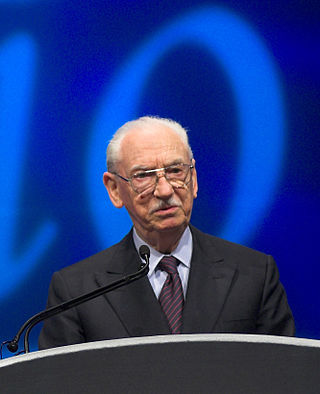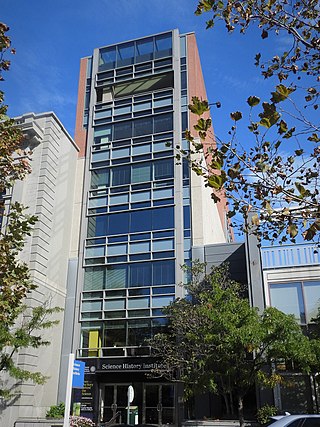
Herbert Wayne "Herb" Boyer is an American biotechnologist, researcher and entrepreneur in biotechnology. Along with Stanley N. Cohen and Paul Berg he discovered a method to coax bacteria into producing foreign proteins, thereby jump-starting the field of genetic engineering. By 1969, he performed studies on a couple of restriction enzymes of the E.coli bacterium with especially useful properties. He is recipient of the 1990 National Medal of Science, co-recipient of the 1996 Lemelson–MIT Prize, and a co-founder of Genentech. He was professor at the University of California, San Francisco (UCSF) and later served as vice president of Genentech from 1976 until his retirement in 1991.

Alfred Robert Bader, CBE was a Canadian chemist, businessman, philanthropist, and collector of fine art. He was considered by the Chemical & Engineering News poll of 1998 to be one of the "Top 75 Distinguished Contributors to the Chemical Enterprise" during C&EN's 75-year history.
The Society of Chemical Industry (SCI) is a learned society set up in 1881 "to further the application of chemistry and related sciences for the public benefit".

Alejandro Zaffaroni was a Uruguayan serial entrepreneur who was responsible for founding several biotechnology companies in Silicon Valley. Products that he was involved in developing include the birth control pill, the nicotine patch, corticosteroids, and the DNA microarray.

John Dombrowski Roberts was an American chemist. He made contributions to the integration of physical chemistry, spectroscopy, and organic chemistry for the understanding of chemical reaction rates. Another characteristic of Roberts' work was the early use of NMR, focusing on the concept of spin coupling.
Tobin Jay Marks is the Vladimir N. Ipatieff Professor of Catalytic Chemistry, Professor of Material Science and Engineering, Professor of Chemical and Biological Engineering, and Professor of Applied Physics at Northwestern University in Evanston, Illinois. Among the themes of his research are synthetic organo-f-element and early-transition metal organometallic chemistry, polymer chemistry, materials chemistry, homogeneous and heterogeneous catalysis, molecule-based photonic materials, superconductivity, metal-organic chemical vapor deposition, and biological aspects of transition metal chemistry.

Peter B. Dervan is the Bren Professor of Chemistry at the California Institute of Technology. The primary focus of his research is the development and study of small organic molecules that can sequence-specifically recognize DNA, a field in which he is an internationally recognized authority. The most important of these small molecules are pyrrole–imidazole polyamides. Dervan is credited with influencing "the course of research in organic chemistry through his studies at the interface of chemistry and biology" as a result of his work on "the chemical principles involved in sequence-specific recognition of double helical DNA". He is the recipient of many awards, including the National Medal of Science (2006).

The Science History Institute is an institution that preserves and promotes understanding of the history of science. Located in Philadelphia, Pennsylvania, it includes a library, museum, archive, research center and conference center.

JoAnne Stubbe is an American chemist best known for her work on ribonucleotide reductases, for which she was awarded the National Medal of Science in 2009. In 2017, she retired as a Professor of Chemistry and Biology at the Massachusetts Institute of Technology.
George Blatz Rathmann (1927–2012) was an American chemist, biologist, pioneer in biotechnology and corporate executive. In 1980 he co-founded and served as the first CEO of Amgen, and later founded Icos.

The Society for Electroanalytical Chemistry (SEAC) is a scientific society based in the United States which promotes advances in both basic and applied research in electroanalysis. Founded in 1984, SEAC has members at all education levels from academia, industry, and government. It provides a platform for the exchange of ideas and recognition of achievement in the electroanalytical community.

The Othmer Gold Medal recognizes outstanding individuals who contributed to progress in chemistry and science through their activities in areas including innovation, entrepreneurship, research, education, public understanding, legislation, and philanthropy. The medal is presented annually under the sponsorship of the Science History Institute and four affiliated organizations: the American Chemical Society (ACS), the American Institute of Chemical Engineers (AIChE), The Chemists' Club, and the American section of the Société de Chimie Industrielle, at the Science History Institute's Heritage Day.

Ralph Landau was a chemical engineer and entrepreneur active in the chemical and petrochemical industries. He is considered one of the top fifty foundational chemical engineers of the first half of the 20th century, and one of the 75 most distinguished contributors to chemical enterprise. He has published extensively on chemical engineering and holds a significant number of patents.
The Petrochemical Heritage Award was established in 1997, "to recognize individuals who made outstanding contributions to the petrochemical community." The award is intended to inspire achievement and to promote public understanding. The award winner is chosen annually by the Founders Club and the Science History Institute. The award is traditionally presented at the International Petrochemical Conference hosted by the American Fuel and Petrochemical Manufacturers (AFPM), formerly known as NPRA, the National Petrochemical & Refiners Association.
John Sears was a salt producer in Massachusetts Bay Colony.
Ram Charan Mehrotra was an Indian analytical and organometallic chemist, academic, educationist and the vice chancellor of the Universities of Delhi and Allahabad. He was known for his studies on the chemical theory of indicators, alkoxides and carboxylates of many elements. He was an elected fellow of the Indian National Science Academy, Indian Chemical Society, Chemical Society of London, Royal Institute of Chemistry, National Academy of Sciences, India and Indian Academy of Sciences. The Council of Scientific and Industrial Research, the apex agency of the Government of India for scientific research, awarded him the Shanti Swarup Bhatnagar Prize for Science and Technology, one of the highest Indian science awards, in 1965, for his contributions to chemical sciences.
Mariappan Periasamy is an Indian organometallic chemist and a professor at the School of Chemistry of the University of Hyderabad. He is known for his experiments using carbon metal bonds for constructing diverse types of molecular structures, and is an elected fellow of the Indian National Science Academy and the Indian Academy of Sciences The Council of Scientific and Industrial Research, the apex agency of the Government of India for scientific research, awarded him the Shanti Swarup Bhatnagar Prize for Science and Technology, one of the highest Indian science awards, in 1996, for his contributions to chemical sciences.

The Gordon E. Moore Medal is an award given yearly by the Society of Chemical Industry to someone who has displayed early career success involving innovation in chemical industries. Success is judged in terms of both market impact and effects on quality of life of their work.
The Société de Chimie Industrielle is an independent learned society inspired by the creation of the Société de Chimie Industrielle in Paris in 1917. The American Section was formed on January 18, 1918, and held its first meeting on April 4, 1918.











